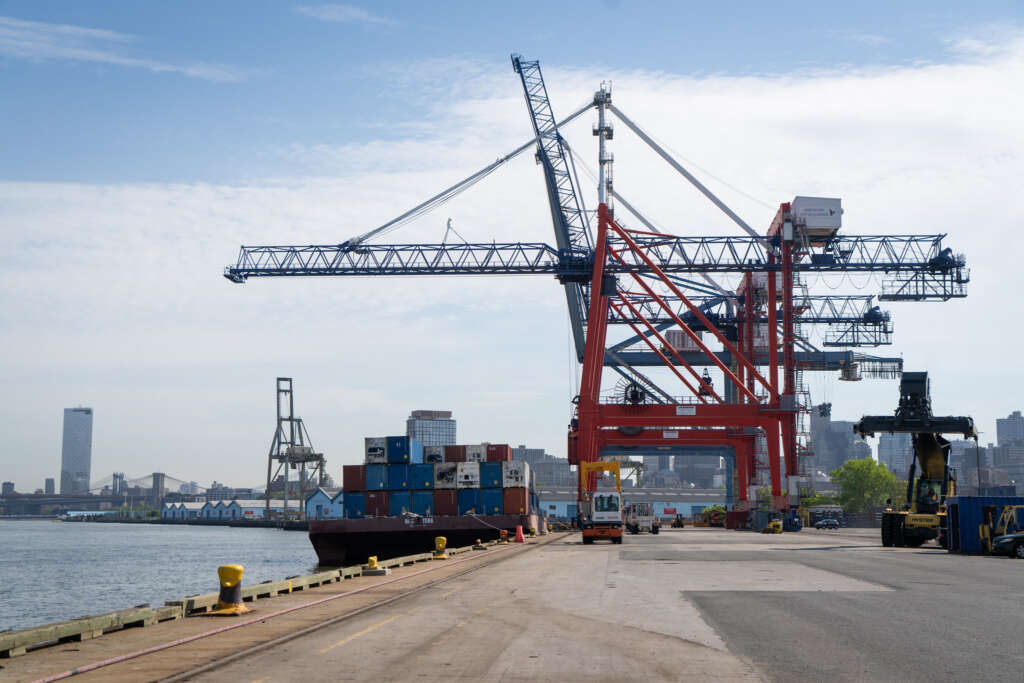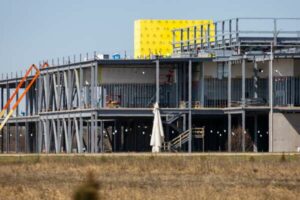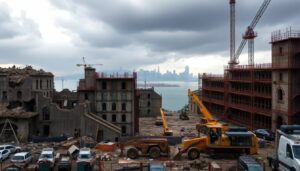“I can’t vote yes on a project in which the majority of the community doesn’t know what’s going on,” Brooklyn Borough President Antonio Reynoso, who sits on the task force that will vote on a final proposal for the Brooklyn Marine Terminal, said at a rally in early April. “I’m on the task force and I don’t know what’s going on.”

In Gowanus, the thud of jackhammers, the scent of fresh asphalt, and the glare of glass towers have become part of daily life as luxury high-rises claim their places by the dozen.
A 2021 rezoning of the area, in the works since 2016, opened the floodgates for this caliber of development, where the median monthly rent now tips over $4,000, according to data from StreetEasy.
Just next door, residents of Red Hook and the Columbia Street waterfront are bracing for a similar building boom.
Stretching from the south of Brooklyn Bridge Park down through Red Hook, the 122-acre Brooklyn Marine Terminal (BMT) is one of the last bastions of New York’s working waterfront, despite decades of disinvestment.
The New York City Economic Development Corporation (EDC) has put forward plans to redevelop the site into the “Harbor of the Future,” with a modernized working port, a hotel, approximately 7,700 new apartments, sorely needed resiliency upgrades, and transportation improvements. Supporters say it’s an opportunity to build quickly on public land to help address a “crushing” housing shortage.
However, the move has invoked the specter of mega-developments past, as residents and public officials have rallied against a planning process they say lacks transparency and would also bring luxury development to a flood-prone and transit-poor community.
In a deal cut with the Port Authority of New York and New Jersey last year, the city exchanged the Howland Hook Terminal on Staten Island for site control of the Brooklyn Marine Terminal, which EDC will manage while the state retains ownership.
The move allows any development there to bypass the typical city land use approvals, including City Council review. Despite managing much of New York’s revenue-generating public land, EDC is not a city agency but rather a public-benefit corporation.
Normally a proposal of this magnitude would go through the city’s Uniform Land Use Review Process or ULURP, which requires proposals to move through several stages of public review.
Instead, the Brooklyn Marine Terminal’s redevelopment will be governed by the state’s development process, known as a General Project Plan (GPP). Compared to ULURP, critics say it offers less transparency and inclusivity.
There are no clear rules for how a GPP gets approved, and once a plan is filed the state is only mandated to hold one public hearing, according to its regulations. The level of transparency and public input is generally at the discretion of those leading the development, John Kaehny of the good government group Reinvent Albany told City & State in 2018, when officials were debating Amazon’s controversial proposal to open a headquarters in Queens, which also would have been dictated by a GPP (the project was ultimately dropped following community pushback).
In the case of the BMT, EDC and Empire State Development would be the authorities ultimately responsible for creating the GPP. Currently in its visioning stages, the EDC has convened a 28-member task force to vote on a final proposal for the site, as well as advisory groups representing local interests including housing, businesses, NYCHA, and the environment.
However, some members working inside the process have expressed frustration and concern at the way EDC has engaged with them and the larger community.
“Their whole thing has sort of just been trying to undermine the task force and sell us on something we’re not interested in, instead of addressing concerns,” says Rebecca Kobert, a representative of Brooklyn Community Board 6 on the task force. “I think people assume a certain level of agency when you say a task force, and I don’t think that’s been especially true.”
The task force was initially slated to vote on a proposal for the site by the end of 2024, only four months after the visioning process began. However, opposition from community members, organizations, and elected officials—some of whom are on the task force—led EDC to push that deadline back multiple times.
“I can’t vote yes on a project in which the majority of the community doesn’t know what’s going on,” said Brooklyn Borough President Antonio Reynoso, who sits on the task force, at a rally in early April. His office will host a public presentation with the EDC on the plans on June 4. “I’m on the task force and I don’t know what’s going on.”
Elected officials, including Councilmembers Alexa Aviles and Shahana Hanif, State Assemblymember Marcela Mitaynes, Congressman Jerry Nadler, and NYC Public Advocate Jumaane Williams spoke at the demonstration, which was organized in part by of Voices of the Waterfront, a coalition of residents and local organizations that has coalesced in response to EDC’s plans for the site.
One by one, speakers asked EDC to “slow down” the process, with many expressing concerns about the negative impact new market-rate housing would have on the community. Congressman Nadler is specifically asking officials to move ahead with the port redevelopment plans, but to “defer housing decisions for later through the ULURP process.”
The task force’s vote is now expected to take place on June 18, a timeline which still outpaces comparable redevelopment projects that went through a GPP, like those for Atlantic Yards and Penn Station.
Currently, the proposal would construct up to 7,700 units of housing on the site, 35 percent of which would be income-restricted, while the remainder would be market-rate rentals and condominiums. Some opposed to the plan want a greater share of affordable units, considering much of the housing would be constructed on public land.

The EDC has argued that there is insufficient funding and that the port alone will not generate enough profit to support necessary infrastructure upgrades and major public improvements. Last December, midway through the visioning process, EDC released analyses showing that market-rate housing would be needed to cover the lion’s share of those costs.
According to memos and presentations EDC has shared with the task force and which have been made publicly available by Community Board 6, EDC has stated that without market-rate housing, the port will continue to deteriorate until its piers will “fall into the water.”
However, some task force members are skeptical of that assertion. Carly-Baker Rice, head of the Red Hook Business Alliance and a member of the task force, said EDC could seek out additional grants and explore additional private investment opportunities, and questioned how fully it assessed the port’s current and projected revenue.
According to Kobert, consultants doing the environmental, financial, and market analyses were brought on just weeks before the task force first convened in late September, developing plans for a complex site within an extremely compressed time frame.* “They’re comparing this to Hudson Yards, they’re saying it’s a city within a city. We don’t want that,” said Kobert.
When asked how it’s responding to concerns around transparency and housing affordability, a spokesperson for EDC disagreed with any characterization that it hasn’t involved the community thoroughly enough.
“Over the last eight months, NYCEDC has continuously engaged with the Brooklyn Marine Terminal task force and advisory groups in addition to over 3,000 community members who have attended our public workshops, site tours, webinars, and feedback sessions,” said Jeff Holmes, EDC’s vice president for public affairs, in an email.
That process has helped identify “key community priorities,” Holmes added, including “the need for a modern and sustainable port focused on getting trucks off our streets, improved transportation options and connections, increased waterfront open spaces, resilient infrastructure and protection from climate change, affordable housing and the development of workforce training and career pipelines.”
“After decades of disinvestment and neglect the port is falling deeper and deeper into disrepair. This is a unique opportunity to deliver a project that will benefit generations of New Yorkers,” he said.
Tiffany-Ann Taylor, a member of the task force and vice president of transportation for the Regional Plan Association, similarly stressed the opportunity the site represents. Redevelopment could bring pedestrian-first streets, potential express bus and additional ferry service, an expanded greenway, and the prioritization of commercial uses on the site. “I am encouraged by the idea that the city is taking resiliency very seriously in this neighborhood,” she said.
However, she echoed concerns about public engagement. “Having worked there and now being on the receiving end, there honestly is quite a bit to be desired as it relates to the city’s engagement on this project,” said Taylor, who used to hold a position in EDC’s transportation department.
On the proposal to construct market-rate housing on the site, Taylor pointed out that “we are talking about brand new development, and partially market-rate development, right across the street from lower income housing.”
“I think it’s right to question, not only is this the best method, but what improvements could be made to the local housing today. Why are investments only being considered for the future residents of the neighborhood? I think those are very natural questions and levels of concern people would have,” she said.
Some critics point to EDC and the city’s history of offering public land to private developers, sometimes despite vocal public opposition.
Development along this potentially lucrative section of the Brooklyn waterfront has long attracted interest from the real estate sector. According to the New York Times, Related Companies—the global real estate developer EDC hired to develop Hudson Yards and now Willets Point—had been lobbying state and local officials to open the site for development long before the land swap, even drafting a proposal for up to 40,000 high-rise housing units.
In November, EDC Chief Operating Officer Melissa Burch presented the planned BMT redevelopment at a panel on real estate investment opportunities, which included Related Companies. (As the proposal is still in its visioning stages, a developer has not yet been selected for the site.)
Additionally, Related Companies has made several political donations in recent years to Congressman Dan Goldman, who chairs the task force and recently authored an op-ed in support of the draft plans. A spokesperson for Congressman Goldman said the contributions have no bearing on his position, which they describe as rooted in a desire to preserve the port.
“Congressman Goldman’s first and most important priority has always been to save and revitalize the Red Hook Marine Terminal, which has suffered from decades of neglect and disinvestment but remains a critical economic, environmental, and national security imperative,” Goldman’s Senior Advisor Simone Kanter said in an email.
He pointed out that future revenues will not be enough to pay for the port’s upgrades, “nor will the federal grant the Congressman helped obtain,” he added, stressing that redevelopment of such a complex property “requires compromise between numerous competing priorities from the communities surrounding the BMT, as well as the City and State governments, which have not been willing to fully finance the necessary investment with public money.”
“The Congressman views his role as the Chair of the Task Force as an advocate to empower these diverse community interests and ensure that EDC is incorporating them in good faith,” Kanter said.
In a Daily News oped, Goldman cited the project as an opportunity to address the city’s “generational housing crisis.”
“We need our community and elected leaders to find a way to get to ‘yes,’ rather than too often catering to legitimate but parochial reasons to get to ‘no,’” the lawmaker wrote.
However, some who are critical of the process believe that framing this simply as an issue of diverging interests obscures imbalances in power and resources among those involved. They also reject characterizations of NIMBY-ism.
“Nobody in the group is opposed to housing. Nobody is opposed to resiliency upgrades. But the process has been pre-determined from the beginning, so all of the community input, what does it even mean?” says Benjamin Werner, a member of Voices of the Waterfront.
Both Atlantic Yards and the Gowanus rezoning, while still fraught, promised 100 percent affordable housing on the public lands included in those redevelopments. “If there is going to be any housing, and it’s publicly owned land, then why wouldn’t it be 100 percent affordable?” Werner asked.
Others said pushback to the proposal is driven not by blanket opposition to development, but by the community’s desire to help shape the future of their neighborhood.
“Why put us as part of a process if you’re not going to meet us where we are at?” says Tiffiney Davis, co-founder of Red Hook Art Project and a member of the NYCHA advisory group weighing in on the proposal. “You can bring in low-income [housing] to a community like Red Hook, but that doesn’t necessarily mean it’s going to benefit the people that’s directly here.”
“I would hope that the EDC understands their role here,” Davis added, “that this is our community and that they need to follow the leaders here and understand what we are asking. My fear is that it may not be up to us.”
*This story was updated since original publication to clarify the timeline for when consultants were brought on for the proposal.
The reach the editor, contact [email protected].
Want to republish this story? Find City Limits’ reprint policy here.



